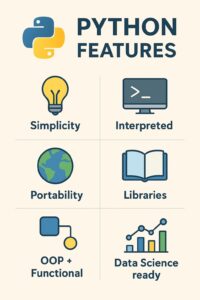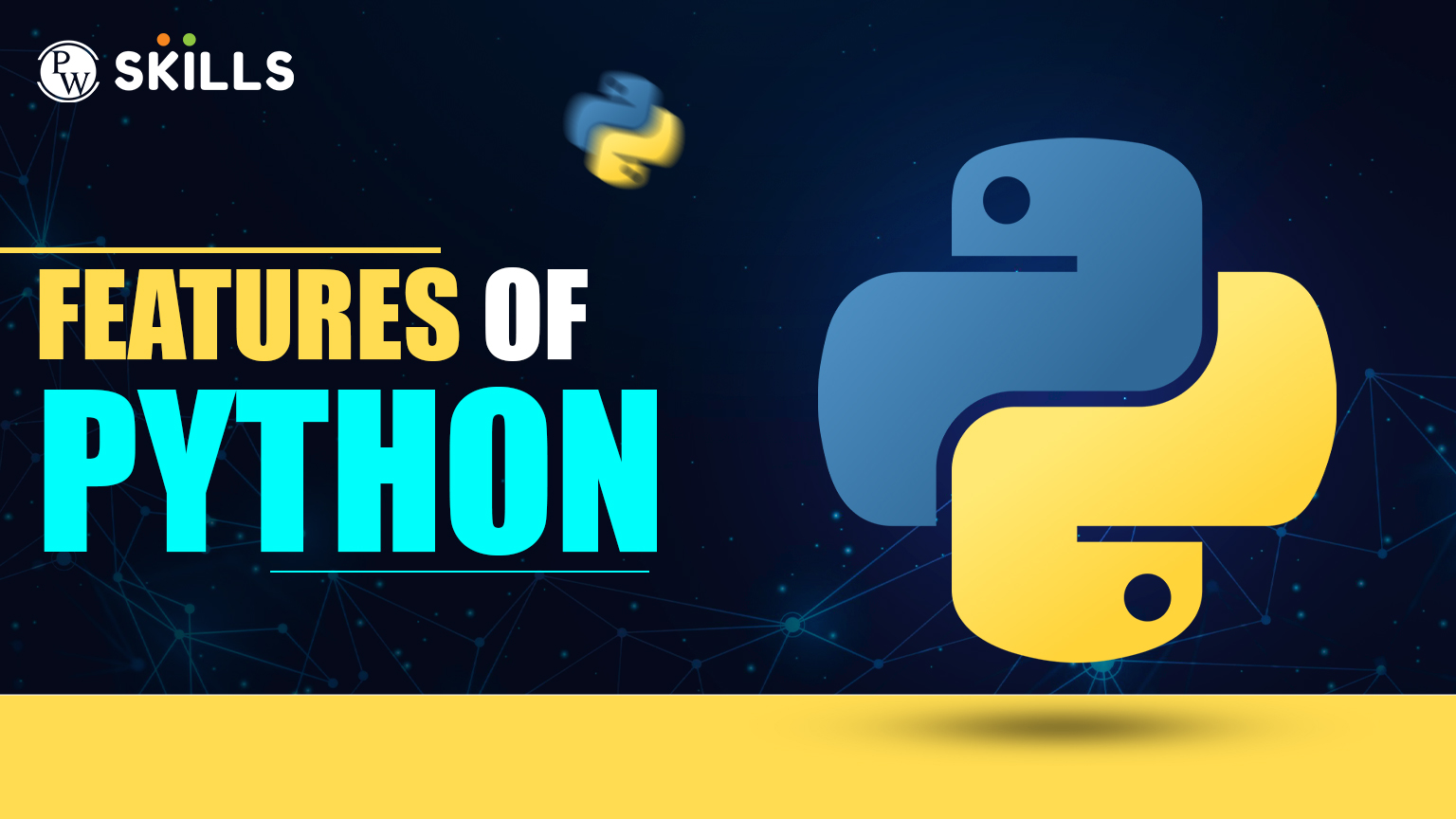Introduction
Python has become the language of choice for developers across the world. Whether you’re a beginner writing your first “Hello World” program or a professional building large-scale applications, the features of Python are what make the journey smoother.
This post outlines 15 features of Python, pulling back the curtains further on their applications and projecting themselves farther into the future yet. Lets dive in.

Historical Background of Python Features
The features of Python evolved over the course of thirty years. The language was incepted by Guido van Rossum in 1991 with the primary goal of creating a programming language that would be “fun to use, powerful, while being friendly”.
In its infancy, Python was mainly about readability and was characterized for its interpreted nature and use of dynamic types.
Parallel to development in the open-source lifestyle gaining enormous recognition, Python exploded through libraries on the web (think Django and Flask).
From the introduction of Python 3 into Python, a decade later emerged compatibility with Unicode, enhanced libraries, and a more efficient treatment of memory.
Today, Python rises on the wings of features in demand, powered by AI, Data Science, and Cybersecurity, forging his way to stiffness in the face of threats looming in the future.
In conclusion, with “How many features are there in Python?” the only true answer can be- they are still keeping the feature count increasing.
15 Important Python Features
So let’s have a detailed look at the features that Python is known for and the reason that you must have it in your skillset.
-
The Simple & Easy-to-Learn Features of Python
One of the key features of Python is its simple-to-use features. If you’re a newbie, you might find the language quite easy. Python removes a lot of the syntax-heavy issues that plague C++ and Java coders.
Example:
print(“Hello, World!”)
That’s all you have to do to start. No semicolons or main function boilerplate needed.
This is why even people with no or little technical background-such as students and even some scientists-prefer Python to quickly put their ideas into code.
-
Interpreted Language – Features of Python That Save Time
What’s unique about Python is that there’s no need for compilation before the actual execution. You just write and run the code, and you get the result right away.
This feature of Python dramatically enhances productivity, rendering debugging and testing faster.
Example:
a = 10
b = 20
print(a + b)
You’ve run it already, no waits for the compiler thereafter. Being interpreted, it has just made Python easy for developers to code.
-
Free and Open Source Features of Python
Of course, Python is free to use. There is no need to pay for licensed copies. Any person out there can have a go at downloading the language, modify and release it for their purposes.
This open-source factor in the language has fostered an expansive international community dedicated to adding libraries, frameworks, and tools that assist in making Python a more powerful language.
-
High-Level Features of Python
Python deals with the lower-level details automatically, leaving you to concentrate on solving the real problem. No need to worry about the memory allocation or garbage collection-it is all done in the background.
This feature thus results in more clean code free of being overly encumbered by unnecessary complexity.
-
Portable Python Features – Write Once, Run Anywhere
Python provides one of the most capable capabilities that software applications can carry across operating systems with no modification.
For instance, a Python script on Mac will work on Windows without any conversion. This is another reason why Python is popular in cross-platform development.
-
Library ecosystem-new age features of Python that, of course, favor us
Python has a vast library, just built-in or may use external libraries. The Python libraries range across things like machine learning, data visualization, web scraping, and automation.
Example: Use a math library
import math
print(math.sqrt(25))
Instead of writing your own square-root logic, you just import the machinery and use it. That’s how Python’s library-rich ecosystem works.
-
The best-known feature of Python – Dynamic Typing
The famous Python USP is dynamic typing: once you declare the var a type, it might just as easily instantiation change to another type in future lines.
Example:
x = 5 # Integer
x = “Hello” # Now a string
…
Hence, the above example taken into account, developers feel at ease to maintain code, keeping in mind the previously stated dynamic behavior. But, all fun aside, it is actually considered as the most powerful asset for Python’s development.
-
Python develops Object-Oriented Features
Python supports OOP which helps in proper organization of code. It allows the notion of creating classes and objects to reflect the real-world entities.
Example:
class Student:
def __init__(self, name):
self.name = name
s1 = Student(“Vanita”)
print(s1.name)
Having a look at this attribute, it is a way of promoting the situation with tolls for reusability, modularity, and scalability in a project.
-
Features of Python in Functional Programming
Python is an OOP language that supports functional programming via the applications of such constructs as map(), filter(), reduce(), and lambda functions.
nums = [1, 2, 3, 4, 5]
squared = list(map(lambda x: x*x, nums))
print(squared)
Thus Python can flexibly change between any number of programming paradigms.
-
Embeddable Features of Python
Python can be embedded with other programming languages like C/C++, which is exceptionally useful in the optimization of performance.
For example, it is used when Python is present inside any large application, enabling scripting.
-
Extensible Features Pyramid of Python
Python can be used to call C/C++ libraries or Java classes. Python projects encompassing this effectiveness are often built to incorporate features where speed and flexibility are just as important.
-
GUI Programming Features of Python
Python enables the building of desktop and mobile apps with elegant interfaces, thanks to libraries such as Tkinter, PyQt, and Kivy.
With this Python feature, the language has the advantage of becoming a complete package. It excels at the back stage and is also suitable for front-end applications.
-
Features of Python in Web Development
Some of the well-known Python Web frameworks include Django, Flask, and FastAPI.
Django → Full-stack development
Flask → Lightweight web apps
FastAPI → High-performance APIs
Consequently, Instagram, Netflix, and Spotify are heavily dependent on Python.
-
Python’s Merits in Data Science and AI
Libraries like Pandas, NumPy, TensorFlow, and Scikit-learn have made Python the primary language in Data Science, Machine Learning, and AI.
A few instances of their application:
- Analyzing customer data
- Predicting stock prices
- Building AI chatbots
This tendency makes Python, in this data-driven world, highly viable for the foreseeable future.
-
The List: The Favorite of Developers
Lists make one of the most commonly used data structures in Python.
Example:
fruits = [“apple”, “banana”, “cherry”]
fruits.append(“orange”)
print(fruits)
List features for Python:
- Mutable (can be changed)
- Can store multiple data types
- Supports slicing and indexing
- Coming to any programming task, lists make Python logic efficient, from managing customer data to processing large data sets.
Python Features and Advantages
With an example-based picture of Python features, it is time to have a look at the main merits:

| Python Features | Advantages |
| Simplicity | Easy for beginners and experts alike |
| Interpreted | Faster debugging and testing |
| Portability | Cross-platform compatibility |
| Libraries | Huge ecosystem for every task |
| OOP + Functional | Supports multiple coding styles |
| Data Science ready | AI/ML applications |
Advanced Python Features Almost Every Developer Needs to Explore
While Python’s main features have been discussed, besides the widely used features, it is another interesting language, as its possibilities are endless to take up to advanced levels. These advanced features and advantages of Python may help you stand out, whether you are going to work on AI, automation, or large-scale web apps.
-
Metaprogramming and Reflection
In Python, the ability to alter the code at runtime is facilitated by reflection and metaclasses. This permits dynamic class formation and virtually adaptation of program behavior on the fly.
Example: Django and Flask rely heavily on metaprogramming to internally register models, views, and routes without having to write boilerplate code explicitly.
-
Generators and Iterators
Generators do not really fall into the limelight of Python features with examples. Most of the time, they prevent memory overload by allowing you to yield one item at a time from very large datasets. For instances: using yield to force a memory-efficient load from a large CSV file into memory one line by one line.
-
Decorators for Code Reusability
Decorators encapsulate functions inside of functions. These are heavily used in logging, authentication, and performance tracking.
Example: @login_required in Django is a decorator that ensures that only logged-in users can access a view.
-
Context Managers
With the use of the with keyword, context managers ensure that resources like files or database connections are cleaned up efficiently without the need for manual cleaning.
Example: The with statement closes a file safely and effectively, instead of manually calling file.close().
-
Asynchronous Programming (async/await)
Today, modern web applications and APIs are coded in a manner that they fully utilise asynchronous programming. Python’s asyncio library helps perform tasks like web scrapping, database queries, or API calls concurrently.
Example: Built around async features, one of Python’s fastest-growing frameworks, FastAPI, does this.
-
Duck Typing and Dynamic Typing
Unlike strongly typed languages like Java, languages such as Python follow the duck typing principle, i.e., if it looks like a duck and quacks like a duck, then it is treated as a duck. This lends more flexibility and delineates strict type enforcement from Python code.
-
Large Libraries and Frameworks from Python
While answering “How many features does Python have?,” the library ecosystem of Python is apparently ignored by almost everyone! NumPy for mathematical calculations, Pandas for data frames, TensorFlow for AI, and Flask for web—there is so much power vested unto this ecosystem, driving the industries.
-
Memory Management and Garbage Collection
Truly, Python has a system that does memory allocation automatically thanks to reference counting and garbage collection. Thus, a programmer gets relieved from some manual workload at times and masters willing to fine-tune memory management in favor of performance.
-
Interoperation
Python can easily integrate with C, C++, Java, and .NET, allowing it to cater to enterprise-level projects. Utilizing tools like Cython, Python adopts the speed of C to simplify the language once again.
-
Machine Learning and AI Powerhouse
Python leads the way in AI and ML, a cutting edge application of Python. TensorFlow, PyTorch, Scikit and more make Python the No. 1 choice for AI professionals.
What Importance Do the Advanced Python Features Hold in a Career?
One who learns these advanced Python features and advantages will surely bid adieu to his status as just a mere “coder” and step into the role of an “ideas man” over time whether it is a student, professional, vocationally inclined, or with a view to their careers. Today, recruiters are not just scouting for people who can make a “Hello World” statement but developers who optimize APIs, manage big data, and develop scalable apps—something Python can achieve.

Security Features in Python
In the current age where everything is digitized, security is more important than ever before. Below are some of the essential security features of Python:
- Memory Management – It can prevent memory leaks in Python through automatic garbage collection.
- Secure Libraries – Secure Framing like Django provides built-in security (against CSRF, SQL Injection, XSS).
- Cryptography Support – The support comprises hashing, encryption, and secure sockets communication.
- Runtime Security – Due to being an interpreted language, Python debug-and-patch is much faster.
Examples of applications for Python in security include secure fintech applications, fraud detection systems, and healthcare platforms, all made for scalability and safety.
Features of Python for Startups versus Features of Python for an Enterprise
For Startups
- Rapid Prototyping – Python has one of its best ease-of-use features, launching MVPs reasonably fast for startups.
- Cost Savings – As an open-source language, Python lowers the development fees.
- Versatility – Python supports everything from building an app, analyzing customer data, to automating tasks.
For Enterprises
- Scalability – Python frameworks (Django, Flask, FastAPI) for enterprises come together to develop large-scale projects.
- Integration – Python supports easy compatibility with C, Java, and cloud technologies.
- Enterprise-Grade Security – due to the strong security features of Python, it is a preferred language in enterprises like finance and health care.
This is why features and benefits are not restricted with Python to one business type; rather, they adapt to scale.
Future of Python Features
How would be the future features of Python? Let us hazard a guess with great boldness:
- Quantum Computing Compatibility- While researchers have begun working on these possibilities, imminent support for quantum libraries may be on the way with Python.
- Strong AI association- Python will most probably have future features on deep learning, neural-symbolic AI, and autonomous systems.
- Weightlessness on the Edge- Python might be adapting lightweight versions for IoT and edge devices.
- Security Layer Built-In- Python would have more enhanced security features catered towards the automatically growing cyber threats.
Hence, when someone asks, “What features of Python will be filling the future?” the answer will sound like this: adaptable, intelligent, and much more automated.
Getting Deeper into Python Features for Data Science & AI
It’s the numerous features of Python that have thrown open the floodgates for AI and Data Science. This is how it dominates:
Data Handling- Data cleaning and analysis becomes effortless with built-in libraries such as Pandas and NumPy.
Machine Learning- With several frameworks like TensorFlow and PyTorch, Scikit-learn gives Python an edge for predictive model development.
Visualization- The feature of clear, customizable visual storytelling is created by tools like Matplotlib and Seaborn.
AI Deployment- Python offers seamless integration with cloud and APIs so that AI applications are production ready.
For instance, the recommendation engine on Netflix, route optimization by Uber, and Google’s AI experiments would show the real-world features of Python in an example.
Why Python?
The features of Python draw beyond “easy syntax” or “interpreted language.” From historical roots to future AI concepts, from security features to startup advantages, Python is a language that is ever-altering with the times.
Thus, whether you are a student learning the features of Python or a professional building enterprise solutions’s understandings of these feature sets of Python will give one a definite edge:
Also Read:
- Inheritance in Python: The Powerful 7 Steps Guide
- History of Python Programming Language, Evolution and Applications
- Python API Tutorial: A Beginner’s 15 Steps Guide to Building & Using Effective APIs
- The Ultimate Guide to Python Data Visualization
Master Python with PW Skills – DSA + Python Course
If you want to go a step reading about the features of Python and go ahead to build projects, PW Skills DSA Python Course is your entry point. Learn Python with real-world examples, strengthen your Data Structures & Algorithms and become job-ready with applied projects. Affordable, practical, and for both students and professionals-PW Skills has you covered.
Simplicity, cost-effectiveness, and rapid prototyping make Python a startup-perfect language. Secure libraries are made available to Python, including memory management, encryption tools, and strong framework-level protections. Expect deeper integration with AI, edge computing support, and framework development for advanced machine learning. Although there are about 15 core features for Python, the ecosystem continuously evolves and brings new tools and frameworks.Features of Python FAQs
What are the features of Python that make it popular among startups?
How do the security features of Python protect applications?
What is anticipated of the future features of Python in AI and Data Science?
How many features does Python have today?

